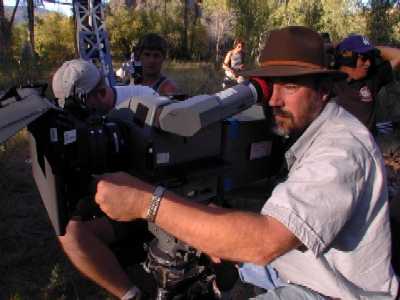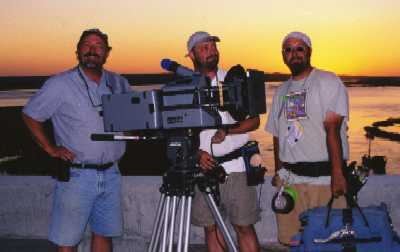Filming of "Lewis & Clark" in IMAX
|
This article first appeared on in70mm.com The 70mm Newsletter |
| Written by: Kurtis Burr | March 2002 |
 T.C. w/ IMAX's MSM 9801. Picture supplied by T C Christensen
T.C. w/ IMAX's MSM 9801. Picture supplied by T C ChristensenFor a week I had the opportunity to work, talk and travel with Director of Photography T.C. Christensen, and discuss the making of National Geographic's new "Lewis and Clark" IMAX film. This interview comprises the bulk of those conversations. "From the start, one of my major concerns was that 90% of this film takes place on rivers." For T.C. this presented the problem of having a very similar look throughout the film. "I wanted to keep the look visually fresh so we decided to achieve this through differing the filtration." Color filtration is not usually associated with large format films. "We began the film with a Tiffen Tobacco 1 filter lending an older, desaturated and muted feel to the images. I felt this would be an effective means to pull the audience into the film through a look that they associate with viewing a historical event. For the winter sequence I used Tungsten film (5274 and 5279) and pulled the 85 filter. It is all quite bluish and cold looking." Cold during the winter segment is an understatement, much like the Corps of Discovery's experience, at one point the wind chill factor reached 30 degrees below zero, fortunately we had the advantage of fleece and hand warmers. The spring sequence was shot with normal color balance, until they reached the Great Falls of Montana. "The portage took the Corps of Discovery nearly a month and just about killed the journey. I used a Tiffen Chocolate 1 filter, which sets apart this sequence with its struggle, sweat and dirt. Everything, the beautiful skies, the cascading blue river are pushed toward a muddy, dirty brown indicating the sweat and struggle of that portage." Additionally T.C. used a Neutral Density .3 or .6 Soft Grad at the top of the frame in most shots. One of its purposes was to knock down the light level in an Omnimax theater setting that would otherwise wash out the image due to reflected light bouncing around the curved screen. He also used ND Grads to help focus the eye because "Most IMAX exteriors are composed with more headroom because the area of interest is located from the screen's center and down through the bottom one-third of frame. The Graduated filter knocks down the brightness of the sky and keeps the audiences' attention focused on the main action. |
Further in 70mm reading: The Witness Testaments |
 Keelboat & Pirouges. Picture supplied by T C Christensen Keelboat & Pirouges. Picture supplied by T C Christensen"One of the biggest challenges in doing an IMAX film about "Lewis and Clark" is trying to capture the incredible scenery they would have experienced almost 200 years ago. I doubt the Corps would recognize today most parts of the waterways they traveled, as it has been so modernized." Most sections of the route Lewis and Clark traveled are now a series of dams. "Many people that come to the theater will do so expecting to see great vistas with shots of these explorers set against the unexplored American west. This was difficult to achieve." One of the only areas left untouched along the Lewis and Clark trail is the Charles M. Russell National Wildlife Refuge in Montana. Unfortunately for us, there is no road access to this area, the only way in and out is by boat. "We wanted to shoot in the Refuge, but it became a question of feasibility - can we float a 32-member principal cast with a crew of over 60 and our equipment in and out each day? Do we spend a week in the Refuge? This forced the production to utilize locations that could be accessed by road. "But, if you can drive to a location there is population which means distant structures, buildings, farmhouses and power lines which are particularly troublesome for a large format film. Extensive CGI work was not an option given the budgetary constraints. It was a "Catch 22", the pristine areas were not accessible and the accessible areas were not pristine. One solution was to have Jack Tankard, who has lensed more IMAX films than most people have seen, and who was the Second Unit Director of Photography, access and shoot sections of the Lewis and Clark route in a manner that the main unit would never have been able to do. To decide the look for National Geographic's "Lewis and Clark" IMAX, T.C. shot a test. "I went out by the Great Salt Lake and used mountains, sky, water and a model. The candidates for filtration were: Straws, Tobaccos, Chocolates and an 81C." The Director Bruce Neibaur and I watched the tests and decided that the Tobacco 1 had the best period look." T.C. also used specialized Grad filters custom made from Tiffen. "Tiffen has made me a Neutral Density .6 Hard Grad that is one-fourth ND and three fourths clear because in large format you use so many wide angle lenses. With a 40mm or 50mm lens and a standard half ND grad, you many times start to see the edges of the filter tray, you literally run out of room. The ND .6 1/4 Hard Grad is perfect in such situations." This isn't the only filter Tiffen has created for T.C.. "On many of the IMAX films I have worked on, I have wished for a way to ND the upper corners but not so much the top of the frame. One idea is to crisscross two ND Grads, one on an angle in the upper left and the other in the upper right. The disadvantage with this is that this results in a straight line and you get a double ND where they meet. Tiffen made me what I call a Half Moon Grad. This enables me to ND around a mountain peak, a person or whatever. Additionally, if the high part of the frame is left or right of center you can't move your tray left or right but you can tape the Half Moon ND onto the hard matte of the Matte Box in order to still use it." Concerning filtration with longer lenses T.C. suggests, "I've found that in IMAX if I'm using anything over 110mm at even a T5.6 that the ND filters are not selective enough, they start to ND the whole frame, or nothing at all. So what I do is take an Arri MB-14 Matte Box and tape the filter to the front of the Hard Matte which pulls the filter another four or so inches away from the lens and sharpens it up. The grips make sure there's no stray light hitting the glass hanging out there and you are ready to Grad a longer lens." T.C. will also bring the Grads in from the sides and the bottom. Specific to Grad Filters in IMAX he believes, "you can get away with heavier Grads because you really don't sit in a theater and take in the entire image at once. The viewer has to decide which part of the screen to look at. As a result you are able to work with a much thicker Grad Filter. When we project the 35mm dailies, many times the Grads seem too heavy. However, when you see it on the big screen it's not that noticeable. |
|
 Left:
DP
T.C. Christensen. Middle: 1st AC
Zep Christensen and right: 2nd
AC and writer of article
Kurtis Burr. Picture supplied by T C Christensen Left:
DP
T.C. Christensen. Middle: 1st AC
Zep Christensen and right: 2nd
AC and writer of article
Kurtis Burr. Picture supplied by T C Christensen
In 1803, the Corps of Discovery was allocated $2,500 and a letter of US credit. Our journey in 2000 cost a bit more. The hard cost involved in shooting IMAX definitely influence all large format DP's. Raw stock averages about $1.15 per foot. Running time for a 1000' roll of film is just under three minutes. The cost of a 35mm print down runs approximately 85 cents per foot. |
|
|
Credits Lewis & Clark Producers: Lisa Truitt & Jeff Miller. Director: Bruce Neibaur. Director of Photography: T.C. Christensen. Production Designer: Andre Guimon. Writer: Mose Richards. Gaffer: Garlan Wilde. Key Grip: Matt Stelling. Assistant Camera: Zep Christensen. Music: Sam Cardon. Editor: Stephen Johnson. DP: T.C. Christensen. 1st AC: Zep Christensen. 2nd AC and writer of article: Kurtis Burr |
|
|
Go: back
- top - back issues Updated 22-01-25 |
